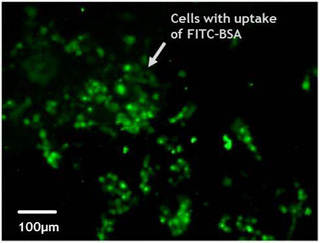UNIVERSITY of WASHINGTON | BOTHELL
Electrical Engineering | Science & Technology

|
Fluorescent image of cells after BSA delivery with a nanoneedle array
|
A Highly Dense Nanoneedle Array for Intracellular Gene Delivery Investigation into cellular functions requires the ability to apply specific and controlled treatment to cells. Such treatment includes the delivery of biological effectors across cell membranes using various approaches such as chemical, mechanical or electrical perturbations to cells. In addition to investigation, gene correction represents an active treatment in which genetic diseases and cancer may be treated by correcting the causative mutations in the genetic code. Sickle cell disease is the most common inherited blood disorder caused by a mutation of a single nucleotide of a gene. The disease causes hemoglobin-containing red blood cells to tend to deform, clump and break apart, resulting in clogged blood vessels and causing severe pain, serious infection and organ damage. Bone marrow transplantation, the only permanent cure for the disease, has the undesirable limitation of donor compatibility. Research has shown that transforming defective blood-forming cells into normal ones by inserting corrective genes can alleviate the disease. Several techniques currently exist for gene correction, including biological methods or physical injection of therapeutic agents into cells. Physical methods such as conventional microinjection typically use glass microcapillaries; however, thesetechniques have relatively low throughput due to the time-consuming operation of targeting individual cell nuclei. A micron-scale microcapillary array, made of SiO2, was previously demonstrated for fluorescent dye injection and DNA injection to plant cells. In this paper we propose a silicon nanoneedle array with needle tip diameters in tens of nanometers, enabling pinpoint injection of individual cells in a high throughput manner without causing cell death by puncture. By exploiting conventional isotropic etching and a thermal-oxidation-based sharpening process, high-density nanoneedle arrays were produced. The nanoneedles possessed sharp tips as small as 16nm in radius and a high density as large as 1000000 per square centimeters regardless of shapes of mask patterns as long as opening gaps between array elements were consistent. The silicon-micromachined nanoneedles were able to deliver small molecules as well as macromolecules into cells by mechanically penetrating cell membranes. The punctured cells showed uptake of calcein and BSA, respectively, with no significant cell death caused by membrane penetration. The demonstration of intracellular delivery with nanoneedles shows promise for high throughput gene transfer. Additional study on correlation of intracellular uptake of macromolecules with mechanical parameters of nanoneedle treatment for cell membrane penetration, and subsequent demonstration of gene incorporation and expression, is required to further validate this technique.
|
|
Email: schoi [at] uwb.edu


